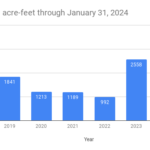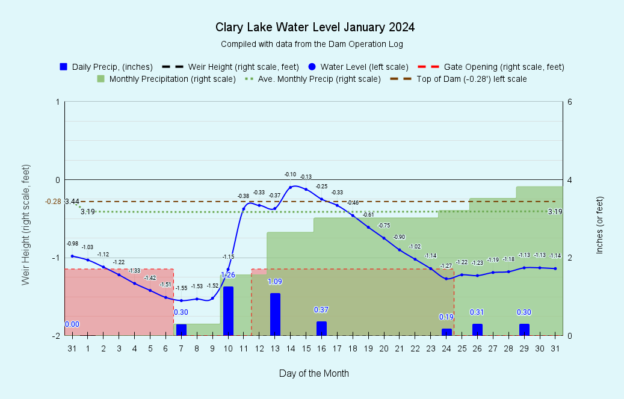I have archived the January 2024 water level chart (above, and at left). With an average monthly precipitation of 3.19 inches, January is normally the least wettest month next to February which averages only 2.61 inches of precipitation, usually in the form of snow. This year however we received 3.82 inches or water or 120% of our normal precipitation on top of the whopping 16″ of surplus rainfall we received in 2023. We had to release a lot of water in January from surface runoff from rain and snow melt and also from ground water to keep the lake level down where it belongs this time of year. We still had water overtopping the dam when the lake rose to within a tenth of a foot of the high water mark on January 14th, an unusual circumstance in January.
High Flows Again!
 Once again we’re starting out the year with much higher than usual outflows from Clary Lake. I posted a chart similar to the one at left last year at the end of February comparing outflows for the first 2 months with those of the previous 3 years, to illustrate how much more water than usual was passing downstream in 2023. This year, after only 1 month, we’ve greatly exceeded last year’s outflows on this date. Whether that trend continues remains to be seen.
Once again we’re starting out the year with much higher than usual outflows from Clary Lake. I posted a chart similar to the one at left last year at the end of February comparing outflows for the first 2 months with those of the previous 3 years, to illustrate how much more water than usual was passing downstream in 2023. This year, after only 1 month, we’ve greatly exceeded last year’s outflows on this date. Whether that trend continues remains to be seen.
High outflows aren’t inherently good or bad for our water quality, but for there to be high outflows there also need to be high INFLOWS and depending on where that inflowing water is coming from, it can have a greater or lesser effect on water quality. When a significant portion of those inflows come from ground water seeping into the lake to replace lost water as has been the case so far this winter (there’s not much surface runoff when the temperature is below freezing!), the impact on water quality is minimal. However, when most of the inflows are in the form of runoff from rain and snow melt as occurs in the spring and summer, significant soil erosion and sedimentation can occur and that is decidedly bad for our water quality because it results in the introduction of Phosphorus into our lake water. Some Phosphorus is good. Too much Phosphorus is bad.
Our concern around water quality therefore is primarily focused on Phosphorus (P) levels in our lake water, where that P is coming from, and the effect high levels of P have on the population of blue-green algae in our lake water. Blue-green algae, also known as Cyanobacteria are bacteria that use plant-like photosynthesis as a source of energy. In sufficient numbers, these bacteria can cause what are referred to as algal “blooms”. Some algal blooms are merely nuisances, turning the water green and murky and causing green scum to accumulate on the surface, but blooms with a real potential to harm human and animal health and/or aquatic ecosystems can happen and are referred to as harmful algal blooms, or HABs. We have experienced HABs on Clary Lake before, though the level of toxicity that has been reached is unknown. We’re not aware of anyone or any animals that have gotten sick from a HAB on Clary Lake, but it certainly is a real possibility.


